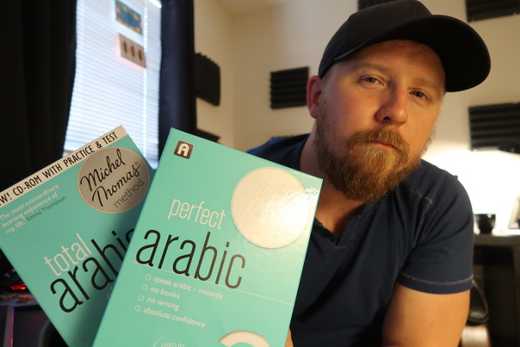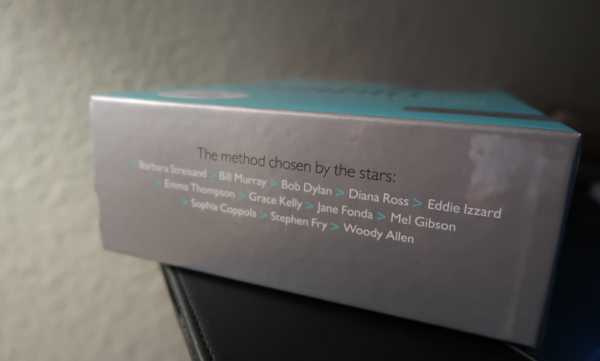Why I Don’t Recommend Michel Thomas (Review)
 Written byHubert Nagel
Written byHubert Nagel- Read time12 mins
- Comments173


- Simplifies various language concepts well
- Good range of languages
- Way too much English
- No listening comprehension
- Teacher is held solely responsible for outcome
- Explicit grammar instruction
- A-list celebrity endorsements without educational endorsements
Michel Thomas' focus on functional building blocks is great, but the course is in no way worthy of its household name in language education. The excessive use of English to 'explain' the target language and a complete lack of listening comprehension deprive learners of any substance.
MT has a cult following and A-list celebrity endorsements but no strong support from linguists or educators.
NOTE: I’ve recommended a far better, more user-friendly (and less expensive) alternative to Michel Thomas recently.
Select a language here:
Make sure to check out my Essential Language Learning Tools page as well for other resources and recommendations.
I was recently sent a few copies of the Michel Thomas Total Arabic and Perfect Arabic courses from the good folks over at Hodder Education in exchange for an honest review.
This is a product that I’ve wanted to look at for a long time as MT is still a very popular course among language learners.
Michel Thomas is a popular household name that most of us are familiar with and it’s certainly a course that I get asked about quite often (particularly the Arabic edition).
I’ve spent the last few weeks meticulously going through the content and researching its method.
Unfortunately, I wanted to include some Q&A with Hodder Education along with this review (I always like to fire off challenging questions to content creators and publishers to get some substantive answers) but Hodder never followed up on my request for additonal information.
Not sure why that is but it’s a shame.
So no Q&A on this one!
However I will provide my in-depth and brutal assessment of the Michel Thomas Method anyway.
Make sure to share your own experience and thoughts in the comment section below.
The Michel Thomas Method has been around for a long time but age is not a reliable indicator of quality
Like so many other products that I’ve taken the time to write about, decent reviews on the Michel Thomas Method are virtually non-existent.
What I have seen first of all is an assumption by many that age = high quality.
As I pointed out in my Assimil, Pimsleur and Rosetta Stone reviews, the fact that something has been around for a long time does not bestow authority.
This is *especially* true in the realm of language education.**
Consensus on effective methods changes dramatically over time, and approaches that were extremely popular decades ago (like that of Michel Thomas) may have been rendered obsolete by contemporary research.
Or it may just be that MT was pioneering and innovative back in the day though it would probably struggle to stand out in today’s market.
I should also add that although Michel Thomas’ famous war story (his Nazi resistance and role in interrogation in WW2) is an incredible tale that’s well documented (there’s even a good biographical account on it), this does not warrant conferring extra weight to his teaching methodology which was developed many years later.
Yes, his story is heroic and inspiring.
No, this did not necessarily make him a good teacher nor did it say it anything about the development of his method.
UPDATE: Shortly after writing this review, I was contacted by an investigative journalist from the LA Times who debunked Michel Thomas’ war story (see his points here).
Ever asked yourself why Michel Thomas is endorsed by so many A-list celebrities?
Before we even get into the substance of the MT Method, there’s one thing that’s always had me curious.
The Michel Thomas Method came out of his Polyglot Institute in Beverley Hills, and seemed to rely heavily on celebrity endorsements rather than letting the method’s results speak for themselves unlike other big name competitors.
It’s a course that’s marketed primarily for and by the rich and famous.
By the way, if there’s anything the recent US election has taught me, it’s that Hollywood endorsements aren’t worth much! (see here and here)
The Michel Thomas Total course sitting in front of me has a dozen A-list celebrities’ names written on it under the heading, “The method chosen by the stars”.

The first thing you see on the Michel Thomas website as soon as you land on it is a big bold quote from Stephen Fry:
“A unique and perfectly brilliant way of teaching languages.”
Then there’s another quote displayed by Woody Allen:
“You learn a language effortlessly. It is amazing. Michel had me speaking French and I learned it in a way I’ve never forgotten, and it was painless. A tremendous experience.”
I should add – Woody’s testimony doesn’t quite match up with this recent interview in France:
I see these A-list endorsements in Michel Thomas advertising, on other reviews and videos and what it says to me is that somebody somewhere probably got paid good money to say very nice things.
These aren’t linguists or teachers making recommendations.
They’re actors.
And they make a living by doing and saying things that aren’t necessarily true.
You are responsible for your own learning
“Before starting, I’m going to set up a very important rule, a very important ground rule and that rule is:
For you never to worry about remembering, never to worry about remembering anything and therefore not to try, never to try to remember anything from one moment to the next.
This is a method with a responsibility for your remembering and for learning… [inaudible]. So if at any point there’s something you don’t remember, this is not your problem.
It will be up to me to know why you don’t remember individually and what to do about it.”
– Michel Thomas, The Language Master 1997
One thing that I find particularly at odds with everything I’ve learned as a language educator is the Michel Thomas emphasis on full teacher responsibility.
The teacher – not the student – is the one responsible for the learning outcome.
In fact, the Michel Thomas website even states:
“There’s no such thing as a poor student, only a poor teacher.”
I can’t disagree with this statement enough and I actually think it’s a very detrimental thing to imply as it leads learners to forever blame teachers for their failures.
While it’s absolutely true that there are some terrible teachers out there who don’t know what they’re doing in the classroom and/or use ineffective teaching methodologies, the responsibility for learning ultimately rests on the learner.
Even as children we can’t be forced to acquire knowledge. We can only be guided.
You can lead a horse to water but you can’t make it drink!
The Michel Thomas classroom is 100% teacher-controlled.
Unlike a contemporary language classroom that uses a communicative approach and allows students to move around, form groups and have the freedom to interact and make mistakes, the MT setting is like a psychiatrist’s couch where the students’ hands are held through every single step of the session.
There are constant error corrections by the teacher.
One main feature of the MT Method is that the teacher maintains flow until a student makes a mistake in which case they’re instantly corrected on the spot before moving on.
While it’s still a contentious issue for some, most language teachers these days would argue against this.
The general consensus in second language teaching these days is to correct errors if there’s a miscommunication in meaning but that stopping students every single time they make a grammar mistake is detrimental to self-esteem and motivation.
Whatever your view or preference is on this issue, it’s worth bearing in mind that the MT classroom is not student-led.
Strong emphasis on the learner not feeling any pressure or stress
“It is very important for you when you walk out not to practice, not to try to remember, not to review mentally and not to test yourself…”
-Michel Thomas
There has been a lot of study on psychological factors relating to language learning and much of it has centered on stress and anxiety.
Without doubt, high anxiety can negatively affect performance, self-esteem and overall acquisition.
So what Michel Thomas has tried to do is to create an atmosphere in the classroom where students feel completely calm with no burden of expectation.
He does this by setting a ground rule where the students are “not to try to remember”.
Now, this may have a positive effect on some students with reduced pressure to perform but I should also note that pressure isn’t always a bad thing. Sometimes we benefit from being under pressure as it pushes us to try harder.
Language is a cognitive skill after all and skills require hard work to improve at.
I also find it really troubling to hear a teacher say “don’t practice” and “don’t review mentally”.
This is terrible advice.
I can’t see any real practical benefit to telling students to do this other than possible stress reduction.
The teacher talks so much English that it feels more like an English lesson
In the Michel Thomas recordings, you hear four people:
The native English-speaking host, a native speaker of the target language (in my case Arabic) and two students.
They call it a virtual classroom where you’re able to put yourself in the students’ place and learn through their mistakes and subsequent error corrections.
Unfortunately the course is almost entirely taken up by English.
If I were to estimate percentages of how much time each person takes up throughout the entire audio course, I’d say the native English speaker is probably about 85%, the students 10% and the native Arabic speaker the remaining 5%.
Ludicrous!
As I was listening to the Egyptian Arabic course, I found myself constantly thinking in frustration:
“Would you just shut up and let Mahmood (the native Arabic speaker) talk please?”
The British woman who hosts and teaches the course is, as Michel Thomas was himself, very much in charge of the lesson.
Mahmood plays a complimentary role and apart from a few cultural notes that he dictates, his primary purpose appears to be to demonstrate correct pronunciation. The British woman teaches the course and periodically refers to him to demonstrate.
Now, I can understand how this may be desirable for some learners.
Some people do find they get a better grasp on concepts when they hear them explained by a speaker of their own language.
And that really is something that she does well admittedly – breaking grammar down into easily digestible concepts.
For example, when she’s talking about mumkin () and laazim () in Egyptian Arabic and the way they’re both used when combined with verbs, in my opinion she does a pretty good job of turning it into a simple concept to grasp for a totally new learner.
But the main issue for me is that her accent is awful.
She continues to teach Arabic using dreadful pronunciation even though there’s a native speaker sitting right beside her. It’s painful at times to listen to.
And in my opinion, you should be learning from native speakers anyway (unless it’s not an option).
This gets me to my next point.
What about listening comprehension in Michel Thomas?
This is by far the biggest problem with the Michel Thomas Method (in my opinion).
The course does not – in any way whatsoever – train listening comprehension skills.
It is in fact 100% devoid of any authentic listening opportunities.
As I always say, listening comprehension is the most difficult part of learning a new language and it takes the longest time to train. You can learn to speak a language very quickly in fact but being able to understand what people are saying when they reply back to you is a skill that takes a lot of time to hone.
I actually find the course to be disingenuous in this regard.
The reason why I say it’s disingenuous is because for the entire duration of the course, the students are being asked questions primarily in English to give a target language response.
Over the duration of the course, they’re learning how to give certain responses when prompted and various mnemonic techniques for remembering words but they’re never really thrown into an actual conversation where they have to apply listening skills.
The course encourages them to think in English the whole time but respond in Arabic.
Naturally, this “no pressure” method does not equip anyone for real-world interaction.
It would be very easy after a week of Michel Thomas classes to think that you’ve learned the target language to a proficient level, then step outside and quickly discover how little you actually know.
The focus on function words, structure and building blocks
If there’s one thing I think that Michel Thomas actually does right, it’s this.
As I said above, the English-speaking teacher does a very good job of breaking grammar down into easily digestible concepts or blocks.
So instead of going into a big spiel about verb conjugation for example, she gives a verb form and then demonstrates how to plug that verb form into a sentence pattern.
This is basically along the same lines as a method I call chunking.
It gets you away from burdensome grammar memorization and focuses more on piecing building blocks together to form coherent and natural sentences.
I explain this in detail here.
For the Arabic edition that I sampled, it does a very good job at this and explains to a degree why MT was able to assure a functional command of the language within days.
NOTE: The levelling of the Michel Thomas Total and Perfect courses are totally incorrect (they suggest Total = Beginner to Intermediate and Perfect = Intermediate to Advanced).
In reality, the short and sparse nature of the content wouldn’t take you beyond an Elementary level at all.
Overall, Michel Thomas is not a course that I’d honestly recommend
Honestly, if it wasn’t for the total lack of listening comprehension and the excessive amount of English, I would be happy to recommend the Michel Thomas Method.
But as it stands, I cannot and will not.
The focus on functional building blocks is excellent and indeed good.
Also, as far as the Arabic edition goes, it’s good to see another product that teaches a spoken dialect (Egyptian) rather than Modern Standard.
But the fact that they have a native speaker present only in a complimentary role, while a non-native English speaker with horrid pronunciation does most of the talking is just baffling to me.
It makes no sense and reduces the overall quality of the course.
I’m also wary of advertising that relies heavily on A-list celebrity endorsement while the founder, Michel Thomas, was evasive about how he developed his method.
If you’re able to pick up a cheap copy then it might help you get started, but in my opinion there are many other courses and products more worthy of the full cost of this program.
Used MT before? Did it help you?
Comment below!
 Grab the link to this article
Grab the link to this article